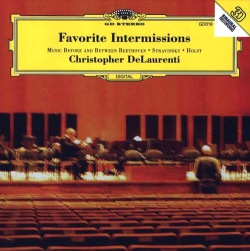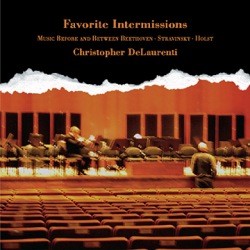Back from the Brink
 At the start of 2007, I told you about my composer/sound-artist pal Chris DeLaurenti’s great new CD release, Favorite Intermissions. A collection of recordings made during symphony concerts around the country, of everything but the concert itself; the warm-ups, noodles and doodles from both pre- and mid-concert, framed to draw our attention to the fun, beauty and serendipity these moments hold. Released on GD Records, it included a wonderfully cheeky cover, a parody/homage to the classic Deutsche Grammophon covers (shown here for illustration only!):
At the start of 2007, I told you about my composer/sound-artist pal Chris DeLaurenti’s great new CD release, Favorite Intermissions. A collection of recordings made during symphony concerts around the country, of everything but the concert itself; the warm-ups, noodles and doodles from both pre- and mid-concert, framed to draw our attention to the fun, beauty and serendipity these moments hold. Released on GD Records, it included a wonderfully cheeky cover, a parody/homage to the classic Deutsche Grammophon covers (shown here for illustration only!):
Response was good, with positive notices in places like the Wire, Signal to Noise and even the New York Times. But an 800-pound fly showed up in the ointment: Universal Music Group, now-parent to Deutsche Grammophon, took a dim view of Chris’ cover-art tribute, demanding that all copies be immediately recalled and destroyed.
 After lengthy negotiation, Chris’ CD has been given the green light again, and is once more available, though now with this slightly revised cover. To learn more about the pieces and concept, you can listen to an interview with Chris about this work, and his musical/phonographic work in general.
After lengthy negotiation, Chris’ CD has been given the green light again, and is once more available, though now with this slightly revised cover. To learn more about the pieces and concept, you can listen to an interview with Chris about this work, and his musical/phonographic work in general.
on the subject of the DG masthead, many many independent record covers have stolen the DG logo outright over the years, without event. I think the recent acquisition by Universal might have more to do with their bizarre move of squashing a CD pressing of 1,000 copies. I’m sad to read the posts upthread from people who consider Universal within rights on this one — legally, yes, morally I’d hope the question was obviously still open
the CD itself is wonderful listening. I’m sure all of us have at times wished to have recordings of a particularly good rehearsal or warmup, particularly with 20th century pieces where a composition’s structure is so much looser — a symphony warming up for an Ives or Varese piece often sounds like an extra piece by the same composer, and the same symphony warming up for Beethoven will often then… sound like Ives taking on Beethoven. I envy the archivist working for the San Francisco Symphony, I’ve got a feeling he’s been saving the warmups — how could he not be, they make for beautiful listening. I only wish it were legally possible to distribute them. But they’re not. DeLaurenti’s on to something here.
“But for a U. like CM with a great school of music, with the presumed interest of furthering the production, not just the reproduction, of classical music, shouldn’t they be promoting at least one living (not to mention relatively young) composer out of three selections?”
Alex/Mr Bacon,
I agree with you 100%
It also struck me that, unless I’m off-base, the program only lasts about, conservatively, seventy minutes [20, 16, 34 minutes?]
I would hope that maybe they were going to sneak in another work by a (younger) living composer, but I’m not so sure. The group seems to have presented several concerts of such modernist masterpieces at venues in D.C., NYC, and Boston, recently.
I notice on the web that when the U. of Chicago partnered with the Chicago Sympony in 1966, they played George Perle and Ralph Shapey, as well as Varese’s Arcana. (I can’t seem to link to the Musical Quarterly review article from 1966.)
That Boston MO Project concert desribed above sounds pretty fantastic!
Thanks also for your other thoughts.
*
[PS. I think that my college orchestra now also features student orchestral compositions; which is a step beyond a generation ago when they would pad their common and modern student orchestra repertoire with chamber orchestra works, or even chamber works, by the likes of Varese, Stravinsky, Crumb, and Birtwistle.]
I wish the Bmore symphony would allow me to conduct my own work. Like that will ever happen. To put it alongside Beethoven is a way to attract a larger audience, but I’d be honored to have my pieces on a show with a Beethoven or Brahms. I think that’s a great program.
As for the other show, let’s have a look:
Varese (1883-1965) – Arcana (1927)
Scelsi (1905-1988) – Four Pieces (1959 – I’m assuming this is the piece ‘Four pieces on a single note, for chamber orch.)
Stravinsky (1882-1971) – Rite of Spring (1913)
All three composers are white males, having died 20, 37, and 43 years ago. Their pieces were written 49, 81, and 95 years ago. I commend any university orchestra on a technical level for good performances of Varese and Stravinsky (though I could care less if a work is technically challenging or not). But for a U. like CM with a great school of music, with the presumed interest of furthering the production, not just the reproduction, of classical music, shouldn’t they be promoting at least one living (not to mention relatively young) composer out of three selections?
College orchestras still have to fight the audience battle, but since they’re funded by their college/university, one might think they have a bit more flexibility in their programming. My college orchestra (Brown) charged something like 2 bucks for students, 5 for everyone else. Compare that to the Baltimore Symphony’s ticket prices. The pro orchestras have obviously got more stock in number of tickets sold. Still, they’re able to put on shows like the MacMillan one. [However, the notion that new music will turn away crowds is untrue, especially in NYC, though the orchestras on the whole still adhere to this principle. If they program new works and lower the ticket prices – and renovate their halls – the crowds will change, but not diminish.] Plus, Alsop is a well known devotee of new music. So they’re doing quite well. Unfortuntely, most orchestras do not program like the Bmore symphony. I’d actually be more critical of U. orchestras who don’t program new music. A recent program (2007) from my former college orchestra, though not much better than the CM program, is still more progressive:
Weber: Oberon
Aziz: Symphonic Poem (Aziz was a senior who wrote the piece as his thesis)
Kraft: Timpani Concerto (played by a sophomore; William Kraft is old, but still living and writing)
Strauss: Till
This program goes back earlier than the CM show and spans through to the present. It covers 182 years, incorporates a 22-year old composer, two dead guys, and an 85-yr-old, a 19-yr-old student soloist. Still, all white male composers. However, I’d go to this show over the CM one. Plus, Brown’s Dept. of Music is small, and the school doesn’t even have a performance minor or certificate degree. So, they don’t get Kennedy Ctr gigs.
Nonetheless, all of these shows undoubtedly have/will have awkward silences between pieces, which I’d rather document/listen to/view than intermissions.
… “but the fact that these intermissions often provide for him more excitement than the works on the program is just one of many examples of the static, and decaying, orchestral landscape.”
Alex/Mr Bacon,
Perhaps I am a conservative, but I am looking forward to Juan Pablo Izquierdo leading the Carnegie Mellon Philharmonic at the Kennedy Center Concert Hall on April 29, in a program of Varese’s Arcana, Scelsi’s Four Pieces for Orchestra, and Stravinsky’s Rite of Spring.
True, it is not a concert by the Klangforum Wien, but it is still a worthy expenditure of student musician, university, and Kennedy Center resources, in my opinion.
What would your alternative orchestral programming idea be for a 2,750 hall? (Alternatively, cite a similarly challenging university orchestra program from the current season.)
*
PS. British composer James MacMillan is leading both his Stomp and Piano Concerto #2 (with Rolf Hind) with the Baltimore Symphony Orchestra this evening. However, rounding out the program is Beethoven Symphony #2.
To me the real significance of the intermission sounds are not the actual sounds at all but the fact that these sounds are not framed by the concert consciousness. They are not meant to be heard; most people don’t listen to them; and most performers don’t play as if they are being listened to. Formal concert settings restrict performers because of the social expectations they impose.
DeLaurenti says the cacophonous warm-up sounds invite the listener into the polyphonic world of the pieces once they begin – they contrast the audibly independent yet codependent lines of much orchestral music. I agree that the disconnected warming-up sounds reveal something that most orchestral music lacks, but it’s not something that it should lack any longer. Aleatoric fragmentation, improvisation, disconnectedness, when not programmed into the score but spontaneous, can function as a mirror or critique of the fragmentation/unpredictability of today. Cage and others’ experiments with multiple orchestras conducted at different rates were great progress, but they are examples of ‘programmed disorder.’ As DeLaurenti says, we don’t hear enough new stuff at orchestral concerts. Even if it’s written in 2008, it probably sounds like it could have been written in 1978. Budgets are what hold orchestras back, and what will probably cause their death not too far in the future, but money aside – orchestral music needs more experimentation, more technology, more risk. That DeLaurenti had to record intermissions, find the ‘best’ ones, and issue them on CD (with a great cover – I agree) is both fantastic and depressing. It’s a cool concept (though I can think of many more interesting environmental settings to play through my stereo), but the fact that these intermissions often provide for him more excitement than the works on the program is just one of many examples of the static, and decaying, orchestral landscape.
Never mind, Joel’s album was published by Schirmer: http://www.gramophone.co.uk/newsMainTemplate.asp?storyID=773&newssectionID=1
This sure seems like a case where Fair Use applies, and like DG is basically using their muscle to coerce the little guy into giving up his rights. I’m not saying I blame DeLaurenti for acquiescing–fighting it would presumably have been a costly lawsuit with no financial upside–but DG is being unreasonable.
Elegant solution to have the same cover with the DG logo “torn off.”
I wonder if Billy Joel had any issues with Schirmer for the cover of his classical piano album? http://en.wikipedia.org/wiki/Fantasies_%26_Delusions
Great news. I’ve heard this CD, it is quite outstanding.
Good idea (the sound/music/etc), I like the title also thanks for the info (the spoof cover is funny imo and was bound to cause trouble, perhaps rightly so)
re trademarks and intellectual ‘property’, the geopolitics/history is worth looking into, no simple answers/arguments.
http://www.worldmapper.org/display.php?selected=99
Frankly, contents aside, that does seem to me to be exactly what trademark law was designed for. I get the intent but it was still sort of a bone-headed move…